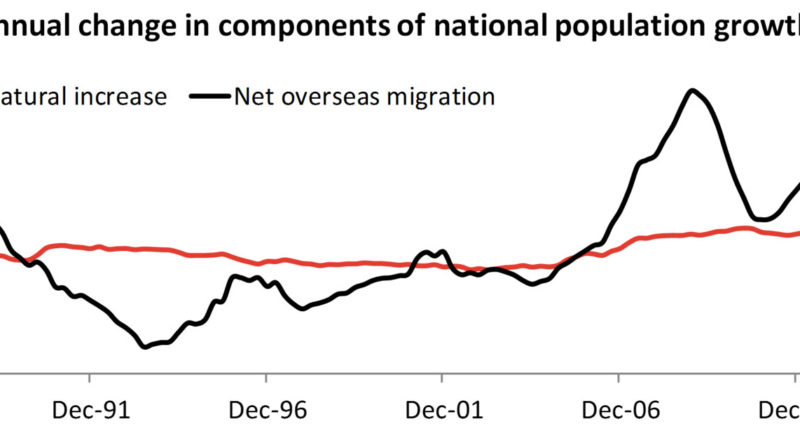Demographic data reveals that the rate of population growth accelerated in 2016
The latest demographic data from the Australian Bureau of Statistics (ABS) shows that the national rate of population growth accelerated in 2016. Australia’s population continues to increase rapidly with the majority of population growth occurring with the two most populous states. New South Wales and Victoria combined accounted for 70.5% of national population growth over 2016.
Over the year, the national population increased by 372,805 persons or 1.6%. The 37,805 person increase was the greatest since March 2014 (373,116 persons) which was also the last time the population grew as rapidly as it is currently. Looking at the components of this population growth nationally, 56% (208,953 persons) was due to net overseas migration with the remaining 44% (152,578 persons) being due to natural increase or the difference between births and deaths.

In terms of annual growth, Victoria (2.4%) has seen its population growth rate dramatically exceed all other states. The Australian Capital Territory (1.7%), New South Wales (1.5%) and Queensland (1.4%) have each seen slower rates of growth but fairly rapid population growth relative to the other states and territories. Elsewhere the annual rates of population growth have been recorded at 0.7% in South Australia, 0.6% in Western Australia and 0.4% in both Tasmania and Northern Territory.
While the rate of population growth tells a story, it is valuable to look at these figures in raw number terms to understand the true magnitude. The annual increases in population in 2016 were recorded at: 116,382 persons in New South Wales, 146,628 (an historic high) in Victoria, 70,442 (greatest since March 2014) in Queensland, 10,322 (lowest since March 2005) in South Australia, 16,835 in Western Australia, 2,972 (highest since March 2011) in Tasmania, 645 in Northern Territory and 6,825 in Australian Capital Territory.
Migration, both from overseas and elsewhere in Australia, has been a key driver of population growth in New South Wales and Victoria. While an increasing number of migrants from overseas are choosing to settle in New South Wales and Victoria, interstate migrants appear to be shunning New South Wales in favour of settling in Victoria and Queensland.
In terms of net overseas migration, each state and territory is attracting more migrants from overseas than the number of residents leaving for overseas. Over the year, the number of net overseas migrants were recorded at: 84,835 persons in New South Wales, 74,051 in Victoria, 23,023 persons in Queensland, 9,942 persons in South Australia, 12,921 persons in Western Australia, 1,261 persons in Tasmania, 838 persons in Northern Territory and 2,074 persons in Australian Capital Territory. Of total net overseas migration New South Wales has accounted for 40.6% and Victoria has accounted for 35.4%. This has risen dramatically over recent years, for example, five years earlier, New South Wales accounted for 27.2% of national net overseas migration and Victoria accounted for 24.5%. At this same time Queensland accounted for 19.6% of net overseas migration compared to 11.0% over the past year and Western Australia accounted for 21.3% compared to 6.2% over the past year. As the mining boom has faded and jobs growth has stalled in these areas, overseas migrants have flooded into New South Wales and Victoria which are home to the strongest employment opportunities.
Interstate migration nets to zero at a national level but it is an important consideration across the individual states. Over the 2016 calendar year, net interstate migration saw positive inflows into Victoria (17,987 persons), Queensland (14,652 persons), Tasmania (467 persons) and Australian Capital Territory (621 persons) while net losses were recorded from New South Wales (-12,822 persons), South Australia (-6,903 persons), Western Australia (-10,824 persons) and Northern Territory (-3,178 persons). Net interstate migration into Victoria is at an historic high and at its highest level since June 2009 in Queensland. Meanwhile, the net outflow is at its highest level since June 2013 in New South Wales, at its greatest level since March 1996 in South Australia and at an historic high in Western Australia. While the New South Wales and Victorian economies are both strong it appears that people who already live in Australia are choosing to move to Victoria rather than New South Wales which is likely to be at least partially linked to housing affordability. This would also help to explain the recent acceleration of net interstate into Queensland and the fade in New South Wales.
The rate of population growth nationally remains rapid nationally with the majority occurring in the two largest states. While Australia has a long history of high rates of population growth fueled by net overseas migration, the data highlights the importance of supporting the high rate of population growth with an appropriate level of dwelling construction and infrastructure investment. Victoria benefits from superior dwelling construction compared to New South Wales (and subsequent lower property prices) as well as having seen significant infrastructure investment over recent years. The strong economy along with superior infrastructure and more affordable housing (relative to Sydney) continues to drive the rate of population growth, largely due to migration, into the states
Source: CoreLogic Feed




